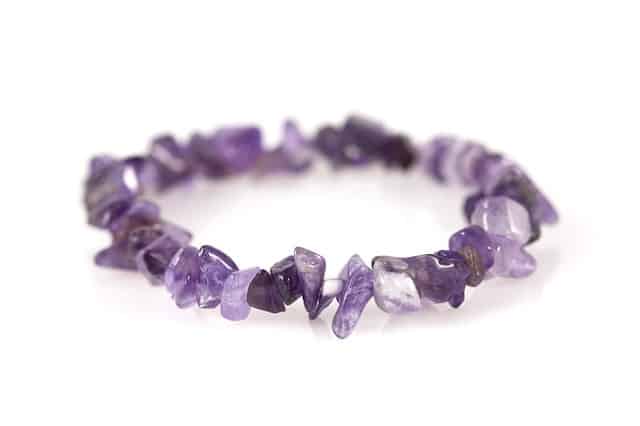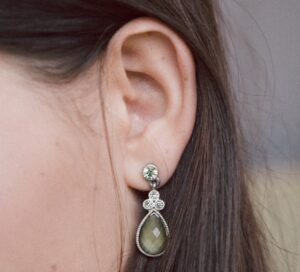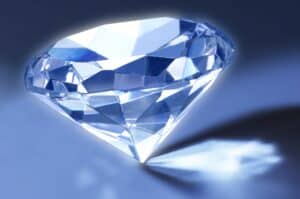Amethyst is a beautiful, violet-colored quartz that has become popular owing to the unique structure of the crystals and the variety of shades it is available in. Amethyst has become a popular stone in jewelry, including rings, bracelets and necklaces. This article examines the everyday wear of amethyst and how you can take care of your amethyst jewelry.
Is amethyst durable enough to wear every day?
Yes, amethyst can be worn every day. It’s hardness on Moh’s scale is 7 which signifies it is hard enough to be used on everyday wear jewelry pieces. However, just like any other stone, there are a few things to consider:
- As prolonged exposure to sun can impact the color of amethyst, you may notice dulled facets and corners.
- If you wear it with other jewelry pieces that are harder, eg. diamond, you may find noticeable scratches on the jewel. These marks and scratches are permanent and cannot be reversed.
- You must avoid wearing it while doing everyday chores like cleaning. This is because alkaline solutions can damage Amethyst. These are commonly present in household cleaners.
- Sudden change in temperature can cause the gemstone to develop cracks. So avoid wearing it under such circumstances.
Is amethyst toxic?
No, amethyst is not toxic. It is a type of quartz that does not show any toxicity. It does not contain any radioactive metals or heavy metals which introduce toxicity to the base structure. It can be worn every day without exposing your body to toxicity.
However, it is worth noting that amethyst dust can be highly toxic. Therefore, be careful with the following:
- Ingestion: Ingesting amethyst powder after it cracks or accidentally swallowing small pieces of amethyst can have adverse effects and.
- Inhalation: If you are reshaping your amethyst crystal, you should not inhale the dust produced during the cutting process. It may lead to silicosis.
Can amethyst get cracked easily?
No, amethyst does not get cracked easily. Amethyst measures 7 on the Mohr hardness scale, which makes it a strong material. It is not easy to chip, crack or break an amethyst stone. However, under certain conditions, it is possible for an amethyst crystal to crack. Your amethyst crystal can be cracked easily if:
- Internal fault: Amethyst crystals with internal defects like cracks, fissures, or inconsistencies can easily crack. They may not need a lot of force and can even break into direct contact with the ground when dropped.
- Structural inconsistencies: Structural inconsistencies are a popular cause for breaking. In layman terms, if the crystal is highly impure, it is more likely to break. True amethyst contains only trace amounts of Fe3+ and therefore appears bright violet. However, if there are higher impurities, the violet color may have a fraction of a shade of another color.
- Cracking on dropping: Like any other crystal, amethyst can break if dropped from a great height. In such a case, the crystal does not need to have high impurity or internal defects.
- Cracking on force: Depending upon the force applied, the crystal may crack. In such a case, the crystal does not need internal defects or structural inconsistencies to be broken.
- Sudden temperature change: Sudden temperature change may cause Amethyst to develop cracks
Can you put amethyst in the sun?
No, you cannot put amethyst in the sun. It is recommended to keep amethyst as far away from the sun as possible because the color of the crystal fades when exposed to sunlight. This is often seen as the color becoming ‘light’ until the crystal appears white-ish with a tinge of violet.
Constant exposure to UV rays in the sunlight may permanently discolor the crystal, making it appear translucent. Amethyst crystal does not need to be ‘cleansed’ in sunlight.
Can amethyst go in saltwater?
Yes, amethyst can be placed in any type of saltwater for up to 48 hours before they start permanently discoloring. A safe duration to keep amethyst in saltwater is about 30 minutes. Post this, the amethyst must be cleaned with fresh water and should be allowed to air dry. No salt deposit should be allowed to rest n the stone as these may eventually enter the crystal and impact it’s shine and appearance.
The types of salt include Himalayan, Epsom salts, sodium chloride (table salt), sodium bicarbonate (baking soda) and borax. They can be placed into any of these salts (for not more than a couple of hours) without facing any adverse effects or discoloration on the amethyst stone.
In fact, Amethyst is usually placed in saltwater to cleanse the crystal. This is because salt has been considered to remove negative energy.

Where do you wear amethyst jewelry?
Amethyst can be worn on various types of jewelry and occasions.
Jewelry Type: Jewelry type in which you can wear amethyst jewelry:
- Necklaces
- Earrings
- Rings
- Charm bracelets
- Beaded bracelets
- Meditating: You may wear or carry amethyst when you meditate
- In Bath: You can wear amethyst while taking a bath
- Parties: Amethyst can be worn to parties as it is a very beautiful looking gemstone. Amethyst in jewelry items that have diamonds or other stones looks spectacular.
- Daily wear: As already discussed, it can be worn in everyday rings, pendants or earrings.
WEARING AMETHYST AS JEWELRY
Are amethyst rings expensive?
It depends! If you are comparing Amethyst to diamond, it is rather affordable. While Amethyst is a semi-precious stone, the value of amethyst depends upon the purity and size of the stone. Impure or smaller stones are cheaper than high-quality geodes. Amethyst comes in 3 qualities and the rings with AAAA quality Amethyst are more expensive than rings that use AA Amethyst. You can buy a ring with AAAA amethyst between $500-$1250. At the same time, the cost of ring with AA amethyst is between $250-$650.
The price for both AAAA and AA is considering that the rings are set in gold of low carat.
In addition to the quality of Amethyst, the price also depends on:
- Size of the stone. Bigger the stone, more expensive it will be.
- The color of the stone. Amethyst that has a weak or light color is considered ‘less’ precious and is cheaper.
- Presence of other gemstones in the ring. If you have other stones like diamonds, pearls, cubic zirconia etc in your ring, the overall price of the ring will be impacted.
- The metal used in the ring. If the ring is crafted in Platinum of god with high carat, it will be expensive. If it has Rhodium plating, the price would be higher. On the other hand, if the ring is crafted in silver or any other cheaper metal like stainless steel, the price would be less.
Can amethyst be used in a ring?
Yes, amethyst can be used as a ring or in jewelry. Types of amethyst crystals:
Type of crystal | Notes |
Amethyst Geode | Used inside the home to improve the healing aura of the home. |
Amethyst Cacoxenite | Used to improve your connection with your chakras and spirit. |
Ametrine | Used to promote mind’s clarity and spiritual healing. |
Amegreen | Used by psychics for clairvoyance and psychic visions. |
Auralite 23 | Used for meditation and spiritual growth. |
Black Amethyst | Used as psychic protection stones and meditation stones. |
Brandberg | Used to promote mental balance and consciousness. |
Chevron Amethyst | Used to relieve stress and tension and promote peaceful sleep. |
Amethyst flowers | Popularly used for home decoration |
Other unique types of amethyst crystals include:
- Pink amethyst
- Elestial amethyst
- Red-tipped amethyst
- Spirit quartz
- Vega Cruz amethyst

What type of jewelry can be worn?
Amethyst can be worn in multiple jewelry types.
- Earrings: Amethyst earrings are available in various shapes, sizes and designs. They can be stud earrings, drops or tear-drop shaped earrings.
- Necklaces: Amethyst necklaces are among the most popular options available. They are chosen because there are a variety of options and they can almost always be worn with all outfits. It is often worn around the neck because there are lower chances of coming in contact with other surfaces.
- Rings: Amethyst rings are a more subtle option if you do not wish to carry your amethyst around your neck. This option is often chosen by people who are comfortable wearing rings for long periods. However, rings are more likely to get damaged since they come in contact with multiple things every day.
- Charm bracelets: Amethyst charms can also be added to existing charm bracelets. These are often small and can be added and removed easily. However, because the amethyst charm is often hanging, the crystal is more likely to be broken.
- Beaded bracelets: Amethyst beaded bracelets are a common choice of jewellery, and can be worn by both men and women. These types of bracelets usually feature circular beads of amethyst. Since there are no sharp corners and angles, they are less likely to be chipped or scratched.
Other popular methods of carrying amethyst are:
- In pockets and purses: Amethyst stones can also be placed in pockets and purses if you don’t wish to wear them with your jewelry. However, extra care needs to be taken with this because your pocket and purse are both likely to hold your other belongings. A special compartment in your purse can be made or, if you’re carrying it in your pocket, you can purchase a small bag that holds only the amethyst.
- In your home: Amethyst geodes can also be placed in your home if you don’t wish to carry the stone with you. This can increase the overall healing power of your home. They can be placed anywhere in your home.
- Amethyst-infused water: Amethyst can be placed inside the water bottle you own. The bottle can be refilled every time to provide you with fresh amethyst-infused water. Additionally, it is also possible to purchase amethyst-infused water bottles from manufacturers. This is believed to improve the endocrine and immune system and improve your skin.
- Placing them in baths: Another popular option that many people use is placing them in baths. The amethyst can be installed permanently in your bathtub, or you can hang it in or around the bath itself. Additionally, you can also carry it inside with you every time. This is believed to improve your skin’s appearance.
Key risk factors for amethyst
Certain risk factors with Amethyst are:
- Heat: Amethyst cannot handle exposure to direct sunlight. The UV rays in the sun can affect the natural properties of the crystal.
- Chemicals: Strong chemicals including acids, bases, sanitisers, hairsprays, household cleaners and perfumes should be kept away from amethyst crystals.
- Swimming pool water: Swimming pool water contains chlorine which can erode the stone.
- Other jewellery: Storing amethyst with other jewellery can cause scratches to appear on the stone.
- DIY cleaning: DIY cleaning with untested chemicals can cause permanent damage to the stone.
- Artificial light: Constant exposure to artificial light can also affect the natural properties of the crystal. It can also have a permanent effect on the color, and you may notice the stone being discolored slowly.
Conclusion
Amethyst crystals are among the most beautiful crystals in the world. They can be worn as jewellery, or they can be carried on the person. Amethyst has also been used in and around a house for home décor and also because they promote the healing energy inside the house.
There are various benefits of using amethyst in your day-to-day life. This article has highlighted the answers to the most popular questions about amethyst and how you can care for your amethyst crystal in the long run.




